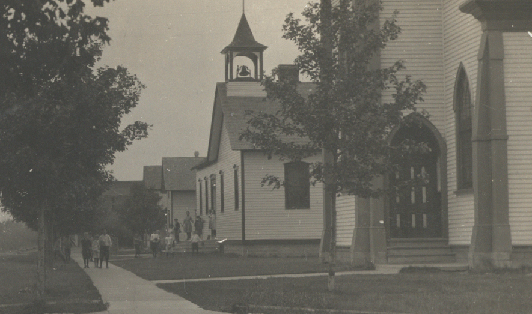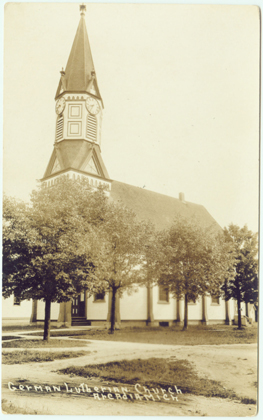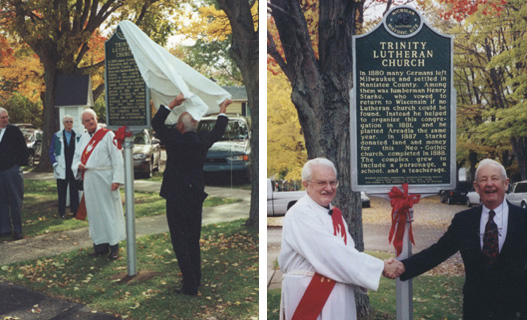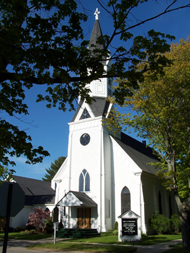A Brief History of the Lutheran Church
|
In the summer of 1880 several German families left Trinity Lutheran Church in Milwaukee to establish a new home in Arcadia, Michigan. At the head was Henry Starke and his wife Maria, and at their side their son-in-law Theodore Ebert and their nephew Henry Mauntler. When Henry Starke left his pastor Rev. Henry F. Sprengler in Milwaukee, he declared "I will not establish a new home for myself and remain there without a church." Well, he established a new home and did much to establish Arcadia too and the church we still see today. Forming Arcadia's Lutheran CongregationThe German settlers who arrived in Arcadia were firmly resolved to form a Lutheran congregation, and on the December 25, 1881, the congregation was formally organized under the name "The evangelical Lutheran congregation of the Unaltered Augsburg Confession in the town of Arcadia, Manistee County, Michigan." The constitution was signed by the following men: H. Starke, H. Mauntler, Theo. Ebert, L. Worch, J. Gerndt, W. Voss, H. Lindenschmidt, A. Jopp, E. Bohms, and F. Bohms. The first officers were President Henry Mauntler, Treasurer Theo. Ebert, Secretary H. Lindenschmidt, and Elders J. Gerndt and L. Worch. This congregation had no pastor, so members of the congregation read prepared sermons and scripture lessons on Sunday mornings and special church festivals. Until 1888 services were conducted in various homes and local buildings including the log cabin near the Starke home, the upper rooms of the Company Store, and the public school. The Congregation's First PastorAt times, neighboring pastors served Arcadia's Lutheran congregation, and Pastor H. Lemke of Manistee was responsible for the pastoral care of this congregation. In 1882 a Sunday school was begun. Shortly after a parish school was started. In 1883 Pastor Lemke officially became the first pastor of this congregation, but he only traveled to Arcadia to preach every two weeks and usually on a week day. A number of Lutheran families came during this time, and the congregation grew: Karl Rubel with his sons Heinrich, Daniel, and Friedrich; Peter Klass; Johan Meitz; Rudolf Schaldach; Th. Rosenblatt; Johann Weldt; Johann Weldt; Karl Nuernberger; C. Manke; and others. When the congregation reached about 25 adults, they started looking for their own full-time pastor, but because of a great shortage of Lutheran ministers at that time, they were not successful until the summer of 1886 when they sent a request to the seminary at St. Louis for a graduate student of divinity. Candidate H. Schmidt accepted and was ordained on September 5, 1886 by Pastor Lemke. Mission Work in Frankfort and OnekamaA week after his installation Pastor Schmidt undertook mission work northward in Frankfort. Two years later mission work was started in Onekama. The Frankfort mission was discontinued for a lack of a building in which to conduct services, but the Onekama mission prospered to such an extent that in ten years they were self-sufficient and called their own pastor. Beginning at the end of 1901 this congregation worked in Cleon Township and there founded the second daughter congregation. |
|
Arcadia's Lutheran ChurchThe congregation had left a beautiful church in Milwaukee, and in the Voters Assembly of January 1887 a committee was chosen to gather plans for a church in Arcadia. Henry Starke donated land, and work on the Lutheran Church began in 1887. In 1888 the church was finished and dedicated. It was a beautiful building that looks much like it does today, 40 ft. x 60 ft. with a 106 foot tower. The wood came from the Starke Sawmill. William Wollschleger carved the pulpit, altar, and stairwells. The pews were manufactured in Milwaukee from Arcadia birdseye maple. The highly accurate Century Tower Clock was made by Nels Johnson of Manistee. Other materials came from the Pritzlaff Hardware Co. of Milwaukee. Total cost: $4,080.33. The dedication festival was something to behold. Henry Starke transported the entire choir from Milwaukee's Trinity Lutheran Church to sing at the event (a capella, because the church didn't have its pipe organ yet). Pastors Lemke and Wilhelm Hagen conducted services in German, and H. Schmidt conducted evening services in English.
In 1901, the pipe organ was added to the church. It was manufactured by the J.G. Pfeffer Co. of St. Louis and cost about $675. With relatively minor changes -- for example, to convert from kerosene to electric lighting, and to modify the front entrance to accommodate coffins, the church was essentially complete. The beautiful stained glass windows that now adorn the Church were installed for the 50th anniversary of its dedication. They were paid for by the Ladies Aid, members, and former members. The Parochial SchoolThe first classes were held in the northern part of the second floor of a building at the Starke Sawmill. The pastor, Rev. H. Schmidt was the first teacher. Several years following the construction of the church in 1888, the congregation began to make plans for the construction of a parochial school, even though they had a debt of $1600, which was significant at the time. A small school was built north of the Church, and on October 10, 1892 the pastor began teaching in the new school, the small part of the present Parish Hall. On August 12, 1897 Pastor J. Schinnerer installed Adolph Hoffmeyer. He would be the parochial school teacher until 1918. In 1904 the congregation built a new house north of the school for the teacher, and the pastor's house, which had been given by H. Starke, was extensively renovated. After several years the school building was not big enough for the number of children who attended. So in 1906 a new 26 ft. x 44 ft. school was built with a small tower and basement, and what had been the old school was used for confirmation classes.
Each morning at 8:15 am, the bell in the tower called kids to school. Classes started promptly at 8:30 am. At first classes were taught in German, but beginning around 1936 classes were taught in English.
The church continued to support a parochial school until 1937 when it had to close for lack of funds. In 1944 the school was reopened and operated until 1946 when it was permanently closed. The school benches were donated to the public school. The congregation continued to maintain the other buildings. In 1947, the teacher's dwelling was completely renovated and supplied with a furnace and hot water. In 1949, a new oil heating system was installed in the church. In 1953, the chimes were installed in the church tower. In 1954, the tower was repaired and reshingled, and the entire church was repainted. In 1955, the old parsonage was sold to Mrs. Selma Forward, but the rest of the buildings are still owned and beautifully maintained by the congregation. |
Pastors Serving the Arcadia Lutheran CongregationRev. H. Lemke 1883-1886 Rev. Henry. Schmidt 1886-1892 Rev. John Schinnerer 1892-1899 Rev. Wm. Bekemeier 1899-1912 Rev. Frederick Seivers 1912-1928 Rev. Herbert Reischauer 1928-1934 Rev. August Freder King 1934-1937 Rev. Harold Ott 1937-1942 Rev. Merlin Sasman 1942-1946 Rev. Geo. Mahder 1947-1953 Rev. Theo. Zetzer 1953-1957 Rev. Gerhard Dobberful 1957 (6 months) Rev. Donald Beyer 1958-1961 Rev. James Moehring 1962-1974 Rev. Raymond Pollatz Sr. 1975-1983 Lay Pastor Richard Korthals 1983-1984 Rev. Calvin Kotzow 1988 Lay Pastor Dick Korthals 1989-1992 Rev. Kenneth Breimeier 1992 Pastor Theo. Beiderwieden 1997- |
The Church TodayIn 2002, Arcadia's Trinity Lutheran Church became a registered Michigan Historic Site. The historic marker reads "In 1880 many Germans left Milwaukee and settled in Manistee County. Among them was lumberman Henry Starke, who vowed to return to Wisconsin if no Lutheran church could be found. Instead he helped to organize this congregation in 1881, and he platted Arcadia the same year. In 1887 Starke donated land and money for this Neo-Gothic church, completed in 1888. The complex grew to include a parsonage, a school, and a teacherage." |
|
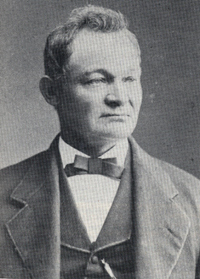
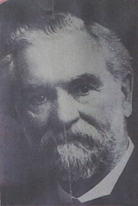
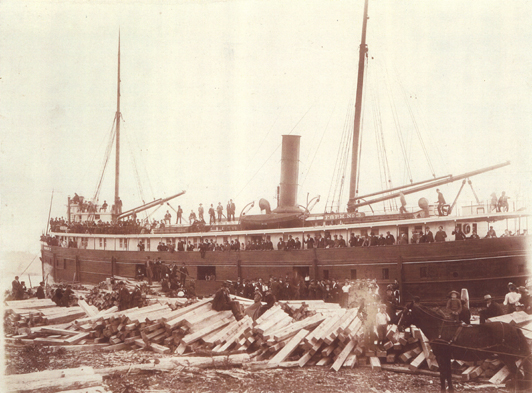
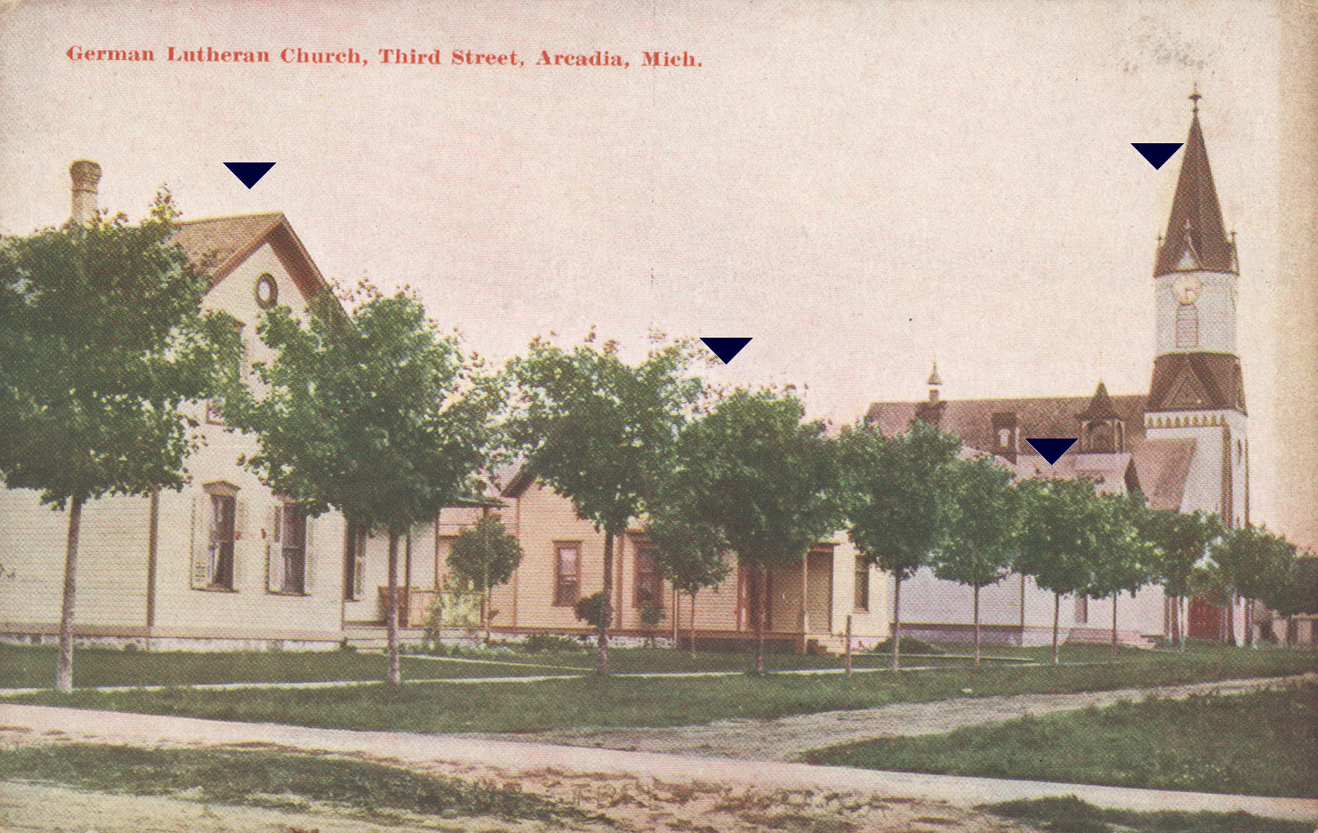 The Lutheran Church Complex
The Lutheran Church Complex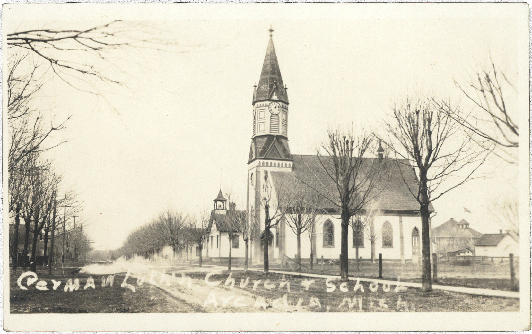 The Lutheran Church and School
The Lutheran Church and School